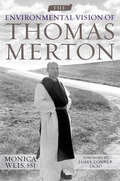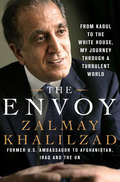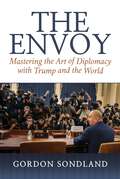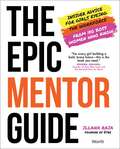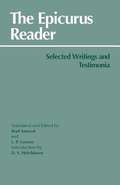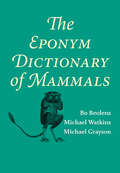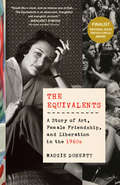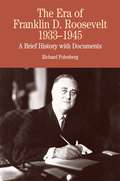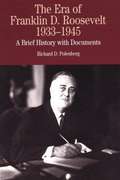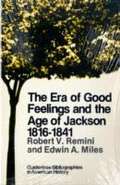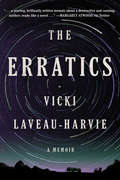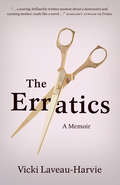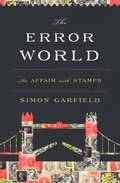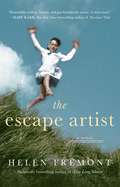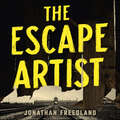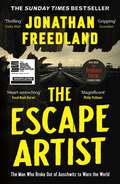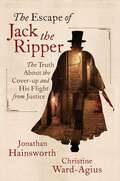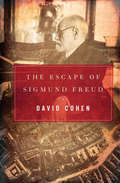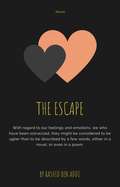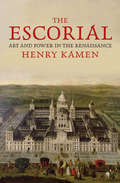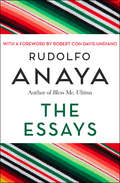- Table View
- List View
The Entertainer
by Margaret TalbotUsing the life and career of her father, an early Hollywood actor, New Yorker writer Margaret Talbot tells the thrilling story of the rise of popular culture through a transfixing personal lens. The arc of Lyle Talbot’s career is in fact the story of American entertainment. Born in 1902, Lyle left his home in small-town Nebraska in 1918 to join a traveling carnival. From there he became a magician’s assistant, an actor in a traveling theater troupe, a romantic lead in early talkies, then an actor in major Warner Bros. pictures with stars such as Humphrey Bogart and Carole Lombard, then an actor in cult B movies, and finally a part of the advent of television, with regular roles on The Adventures of Ozzie and Harriet and Leave It to Beaver. Ultimately, his career spanned the entire trajectory of the industry. In her captivating, impeccably researched narrative—a charmed combination of Hollywood history, social history, and family memoir—Margaret Talbot conjures warmth and nostalgia for those earlier eras of ’10s and ’20s small-town America, ’30s and ’40s Hollywood. She transports us to an alluring time, simpler but also exciting, and illustrates the changing face of her father’s America, all while telling the story of mass entertainment across the first half of the twentieth century. .
The Enthusiast: How the Best Friend of Francis of Assisi Almost Destroyed What He Started: The Untold Story of Elias of Cortona
by John M. SweeneyPopular historian and award-winning author relates the untold story of St. Francis of Assisi's friendship with Elias of Cortona, the man who helped him build the Franciscan movement. Sweeney uses the complexities of their relationship in a gripping manner, showing how their efforts changed the world and how Elias's enthusiasm betrayed the ideals of his friend.
The Environmental Vision of Thomas Merton (Culture Of The Land Ser.)
by Monica Weis“Delightful . . . a superb guide to the ecological themes of Merton’s life and writings.” ?The Christian CenturyNature was always vital in Thomas Merton’s life, from the long hours he spent as a child watching his father paint landscapes in the fresh air, to his final years of solitude in the hermitage at Our Lady of Gethsemani, where he contemplated and wrote about the beauty of his surroundings. Throughout his life, Merton’s study of the natural world shaped his spirituality in profound ways, and he was one of the first writers to raise concern about ecological issues that have become critical in recent years.In The Environmental Vision of Thomas Merton, Monica Weis suggests that Merton’s interest in nature, which developed significantly during his years at the Abbey of Gethsemani, laid the foundation for his growing environmental consciousness. Tracing Merton’s awareness of the natural world from his childhood to the final years of his life, Weis explores his deepening sense of place and desire for solitude, his love and responsibility for all living things, and his evolving ecological awareness.“Explains how Merton evolved from a nature enthusiast . . . to one of the world’s most respected ecological stewards.” ?Louisville Courier Journal
The Envoy: From Kabul to the White House, My Journey Through a Turbulent World
by Zalmay KhalilzadZalmay Khalilzad grew up in a traditional family in the ancient city of Mazar-i-Sharif, Afghanistan. As a teenager, Khalilzad spent a year as an exchange student in California, where after some initial culture shocks he began to see the merits of America's very different way of life. He believed the ideals that make American culture work, like personal initiative, community action, and respect for women, could make a transformative difference to his home country, the Muslim world and beyond. Of course, 17-year-old Khalilzad never imagined that he would one day be in a position to advance such ideas.With 9/11, he found himself uniquely placed to try to shape mutually beneficial relationships between his two worlds. As U.S. Ambassador to Afghanistan and Iraq, he helped craft two constitutions and forge governing coalitions. As U.S. Ambassador to the UN, he used his unique personal diplomacy to advance U.S. interests and values. In The Envoy, Khalilzad details his experiences under three presidential administrations with candid behind-the-scenes insights. He argues that America needs an intelligent, effective foreign policy informed by long-term thinking and supported by bipartisan commitment. Part memoir, part record of a political insider, and part incisive analysis of the current Middle East, The Envoy arrives in time for foreign policy discussions leading up to the 2016 election.
The Envoy: Mastering the Art of Diplomacy with Trump and the World
by Gordon SondlandThis is a behind-the-scenes look at Trump, his cabinet, and an international diplomacy you&’ve never seen before—written by someone with no scores to settle, no hidden agenda, no check to cash, and no fucks to give.If you&’ve heard of Gordon Sondland, it&’s likely for one of the following two reasons: one, that he served as the US ambassador to the European Union as a political appointee of President Trump; or two, that he appeared as a pivotal witness in Trump&’s impeachment trial. Yes, Sondland is the &“quid pro quo&” guy. But as it turns out, he has plenty to say that&’s far more memorable. People still stop Sondland at the grocery store or in the airport—Republicans and Democrats alike—and offer him high-fives. Business associates, strangers, and even close friends still ask him: &“How did you do that?&” What they&’re really asking is: How did he survive Trump? How did he handle being grilled by the Senate intelligence committee? How did he come out of the situation intact, able to move on? These are just a few of the questions Sondland wants to answer in The Envoy—a surprising and endlessly amusing account of inflated egos, botched phone calls, bad behavior, and international jujitsu.
The Epic Mentor Guide: Insider Advice for Girls Eyeing the Workforce from 180 Boss Women Who Know
by Illana RaiaImagine if you found the perfect mentor before you actually started work? Now imagine you could ask her anything. The Epic Mentor Guide matches questions from girls eyeing and entering the workforce with answers from 180 boss women already there.Wondering what it&’s like to be the first female coach or general manager of any men&’s professional sports team? Ask Nancy Lieberman or Kim Ng. Want to know what Veronica Beard thinks you should wear to work, why Tyra Banks over-prepares for every meeting, how Haben Girma graduated Harvard Law School deaf and blind, or what Bobbi Brown wants you to do when you hear the word no at work? We did too. Thinking about careers in media, medicine, or metadata? Wish you could interview TheSkimm founders, NASA astronauts, Olympic athletes, or execs at companies like Billboard, Spotify, ESPN, NIKE, LEGO, TikTok, Google, and the NYSE? We felt the same way. You asked. So we asked. Answering girls&’ questions from around the globe about diversity and inclusion, raising hands, speaking up, and standing out, The Epic Mentor Guide is your early inside track to the work world. Created by Illana Raia, founder of the mentorship platform Être, and featuring women who remember what it felt like to take that first step on their career path, this book is for every girl building a future . . . from epic women building a pipeline. Hear from . . . Angela Duckworth … on Getting Your Grit Together Anita Bhatia … on Applying UN Goals to Personal Goals Blake Bolden … on Breaking Glass Ceilings With a Hockey Stick Daisy Auger-Dominguez … on Asking About Inclusion in Interviews Hoda Kotb … on Staying Resilient in the Face of Challenges Kara Goldin … on Taking a Hint and Building an Empire Lilly Ledbetter … on Negotiating a Strong Salary Raise Rebecca Minkoff … on Finding Female-Focused Networks Sudi Green … on Getting Your First Sketch on SNL And so many more!
The Epicurus Reader: Selected Writings and Testimonia
by Brad Inwood D. S. Hutchinson Epicurus L. P. GersonTABLE OF CONTENTS: Introduction The ancient biography of Epicurus The extant letters Ancient collections of maxims Doxographical reports The testimony of Cicero The testimony of Lucretius The polemic of Plutarch Short fragments and testimonia from known works: * From On Nature * From the Puzzles * From On the Goal * From the Symposium * From Against Theophrastus * Fragments of Epicurus' letters Short fragments and testimonia from uncertain works: * Logic and epistemology * Physics and theology * Ethics Index
The Eponym Dictionary of Mammals
by Michael Watkins Bo Beolens Michael GraysonLearn the origins of over 2,000 mammal species names with this informative reference guide.Just who was the Przewalski after whom Przewalski's horse was named? Or Husson, the eponym for the rat Hydromys hussoni? Or the Geoffroy whose name is forever linked to Geoffroy's cat? This unique reference provides a brief look at the real lives behind the scientific and vernacular mammal names one encounters in field guides, textbooks, journal articles, and other scholarly works.Arranged to mirror standard dictionaries, the more than 1,300 entries included here explain the origins of over 2,000 mammal species names. Each bio-sketch lists the scientific and common-language names of all species named after the person, outlines the individual’s major contributions to mammalogy and other branches of zoology, and includes brief information about his or her mammalian namesake’s distribution. The two appendixes list scientific and common names for ease of reference, and, where appropriate, individual entries include mammals commonly—but mistakenly—believed to be named after people.The Eponym Dictionary of Mammals is a highly readable and informative guide to the people whose names are immortalized in mammal nomenclature.“A small treasure trove of information about the people whose names are immortalized in mammalian nomenclature. Given that we mammalogists are prone to ancestor worship, I expect it to be a best-seller.” —Don E. Wilson, Journal of Mammalian Evolution“This is a great reference for the mammalogy professional or student, or the curious naturalist.” —Wildlife Activist“This is a splendid book which fills a real gap in zoological literature.” —Nicholas Gould, International Zoo News
The Equivalents: A Story of Art, Female Friendship, and Liberation in the 1960s
by Maggie DohertyThe timely, never-before-told story of five brilliant, passionate women who, in the early 1960s, converged at the newly founded Radcliffe Institute for Independent Study and became friends as well as artistic collaborators, and who went on to shape the course of feminism in ways that are still felt today.In 1960, Harvard's sister college, Radcliffe, announced the founding of an Institute for Independent Study, a "messy experiment" in women's education that offered paid fellowships to those with a PhD or "the equivalent" in artistic achievement. Five of the women who received fellowships--poets Anne Sexton and Maxine Kumin, painter Barbara Swan, sculptor Mariana Pineda, and writer Tillie Olsen--quickly formed deep bonds with one another that would inspire and sustain their most ambitious work. They called themselves "the Equivalents." Drawing from notebooks, letters, recordings, journals, poetry, and prose, Maggie Doherty weaves a moving narrative of friendship and ambition, art and activism, love and heartbreak, and shows how the institute spoke to the condition of women on the cusp of liberation.
The Era of Franklin D. Roosevelt, 1933–1945: A Brief History With Documents (The Bedford Series In History And Culture)
by Richard PolenbergThe era of Franklin D.Roosevelt and the New Deal was a time of depression and despair, economic rebirth and renewal, and mobilization for a war in both the East and the West. Richard Polenberg's introduction to this new volume provides an engaging historical and biographical overview of the period by focusing on one of its key actors. <P><P>The biographical introduction is followed by over 45 topically arranged primary sources that provide students with a rich context in which to understand FDR's multifaceted role as president, reformer, policymaker, and commander-in-chief. <P><P>The readings thoroughly cover issues of race and ethnicity, profile First Lady Eleanor Roosevelt, and explore the New Deal's transformative agencies for their economic and social ramifications and the constitutional revolution they triggered. A chronology, questions for consideration, a selected bibliography, and an index are also provided.
The Era of Franklin Delano Roosevelt, 1933-1945: A Brief History with Documents
by Richard PolenbergThe era of Franklin D. Roosevelt and the New Deal was a time of depression and despair, economic rebirth and renewal, and mobilization for a war in both the East and the West. Richard Polenberg's introduction to this new volume provides an engaging historical and biographical overview of the period by focusing on one of its key actors. The biographical introduction is followed by over 45 topically arranged primary sources that provide students with a rich context in which to understand FDR's multifaceted role as president, reformer, policymaker, and commander-in-chief. The readings thoroughly cover issues of race and ethnicity, profile First Lady Eleanor Roosevelt, and explore the New Deal's transformative agencies for their economic and social ramifications and the constitutional revolution they triggered. A chronology, questions for consideration, a selected bibliography, and an index are also provided.
The Era of Good Feelings and the Age of Jackson, 1816-1841
by Robert V. ReminiVolume II of Robert V. Remini's biography of Andrew Jackson
The Erie Canal Sings: A Musical History of New York's Grand Waterway
by Bill Hullfish Dave RuchLife working along the banks of the Erie Canal is preserved in the songs of America's rich musical history. Thomas Allen's "Low Bridge, Everybody Down" has achieved iconic status in the American songbook, but its true story has never been told until now. Erie songs such as "The E-ri-e Is a-Risin'" would transform into "The C&O Is a-Risin'" as the song culture spread among a network of other canals, including the Chesapeake and Ohio and the Pennsylvania Main Line. As motors replaced mules and railroads emerged, the canal song tradition continued on Broadway stages and in folk music recordings. Author Bill Hullfish takes readers on a musical journey along New York's historic Erie Canal.
The Erratics: A Memoir
by Vicki Laveau-Harvie"...a searing, brilliantly-written memoir about a destructive and cunning mother; reads like a novel..." --Margaret Atwood via Twitter In this award-winning memoir, two sisters reckon with the decline and death of their outlandishly tyrannical mother and with the care of their psychologically terrorized father, all relayed with dark humor and brutal honesty.When her elderly mother is hospitalized unexpectedly, Vicki Laveau-Harvie and her sister travel to their parents' ranch home in Alberta, Canada, to help their father. Estranged from their parents for many years, they are horrified by what they discover on their arrival. For years their mother has camouflaged her manic delusions and savage unpredictability, and over the decades she has managed to shut herself and her husband away from the outside world, systematically starving him and making him a virtual prisoner in his own home.Rearranging their lives to be the daughters they were never allowed to be, the sisters focus their efforts on helping their father cope with the unending manipulations of their mother and encounter all the pressures that come with caring for elderly parents. And at every step they have to contend with their mother, whose favorite phrase during their childhood was: "I'll get you and you won't even know I'm doing it."Set against the natural world of the Canadian foothills ("in winter the cold will kill you, nothing personal"), this memoir--at once dark and hopeful--shatters precedents about grief, anger, and family trauma with surprising tenderness and humor.
The Erratics: A Memoir
by Vicki Laveau-HarvieIn this award-winning memoir, two sisters reckon with the convalescence and death of their outlandishly tyrannical mother and the care of their psychologically terrorized father, all relayed with dark humour and brutal honesty.When Vicki and her sister learn their mother has been hospitalized for a broken hip, they return to their parents' home in Alberta to put things back in order. Though their parents disowned them years before, the sisters now reassert themselves in the dysfunctional household: their father, undernourished and suffering from Stockholm syndrome, is unable to see that he is in danger from his outlandish and vindictive wife. Rearranging their lives to be the daughters they were never allowed to be, the sisters focus their efforts on helping their father cope with the unending manipulations of their mother, and must encounter all the characters common in the circus of caretaking--oddball nurses and home helpers; over-opinionated hospital staff who have fallen for their mother's compulsive lies--along with the pressures that come with caring for elderly loved (and sometimes unloved) ones.Set against the natural world of remotest Alberta ("in winter the cold will kill you, nothing personal"), this memoir--at once dark and hopeful--shatters precedents about grief, anger and family trauma with surprising tenderness and humour.
The Error World: An Affair with Stamps
by Simon GarfieldAn obsessively readable memoir about the passions—and perils—of collecting, from the New York Times–bestselling author of Just My Type. From the Penny Red to the Blue Mauritius, generations of collectors have been drawn to the mystique of rare stamps. Once a widespread pastime of schoolboys, philately has increasingly become the province of older men obsessed with the shrewd investment, the once-in-a-lifetime find, the one elusive beauty that will complete a collection and satisfy an unquenchable thirst. As a boy, Simon Garfield collected errors—rare pigment misprints that create ghostly absences in certain stamps. Then, in his mid-forties, this passion reignited—and it began to consume him. In the span of a couple of years, he amassed a collection of errors worth upwards of forty thousand British pounds. But as he was pursuing this secret passion, he was also pursuing a romantic one—while his marriage disintegrated. In this unique memoir, Simon Garfield twines the story of his philatelic obsession with an honest, engrossing exploration of the rarities and absences that both limit and define us. The end result is a thoughtful, funny, and enticing meditation on the impulse to possess.
The Escape Artist
by Helen FremontA luminous family memoir from the author of the critically acclaimed Boston Globe bestseller, After Long Silence, lauded as &“mesmerizing&” (The Washington Post Book World), &“extraordinary&” (The Philadelphia Inquirer), and &“a triumphant work of art&” (Publishers Weekly, starred review).In the tradition of Alison Bechdel&’s Fun Home or George Hodgman&’s Bettyville, Fremont writes with wit and candor about growing up in a household held together by a powerful glue: secrets. Her parents, profoundly affected by their memories of the Holocaust, pass on, to both Helen and her older sister, a penchant for keeping their lives neatly, even obsessively compartmentalized, and a zealous determination to protect themselves from what they see as danger from the outside world. She delves deeply into the family dynamic that produced such a startling devotion to secret keeping, beginning with the painful and unexpected discovery that she has been disinherited in her mother&’s will. In scenes that are frank, moving, and often surprisingly funny, Fremont writes about growing up in such an intemperate household, with parents who pretended to be Catholics but were really Jews—survivors of Nazi-occupied Poland. She shares tales of family therapy sessions, disordered eating, her sister&’s frequently unhinged meltdowns, and her own romantic misadventures as she tries to sort out her sexual identity. In a family devoted to hiding the truth, Fremont learns the truth is the one thing that can set you free. Scorching, witty, and ultimately redemptive, The Escape Artist is a powerful contribution to the memoir shelf.
The Escape Artist: The Man Who Broke Out of Auschwitz to Warn the World
by Jonathan FreedlandThe astonishing, forgotten story of the hero who escaped from Auschwitz to reveal the truth of the Holocaust.In April 1944 a teenager named Rudolf Vrba was planning a daring and unprecedented escape from Auschwitz. After hiding in a pile of timber planks for three days while 3,000 SS men and their bloodhounds searched for him, Vrba and his fellow escapee Fred Wetzler would eventually cross Nazi-occupied Poland on foot, as penniless fugitives. Their mission: to tell the world the truth of the Final Solution.Vrba would produce from memory a breathtaking report of more than thirty pages revealing the true nature and scale of Auschwitz - a report that would find its way to Roosevelt, Churchill and the Pope, eventually saving over 200,000 Jewish lives.A thrilling history with enormous historical implications, THE ESCAPE ARTIST is the extraordinary story of a complex man who would seek escape again and again: first from Auschwitz, then from his past, even from his own name. In telling his story, Jonathan Freedland - the journalist, broadcaster and acclaimed, multi-million copy selling author of the Sam Bourne novels - ensures that Rudolf Vrba's heroic mission will also escape oblivion.(P) 2022 Hodder & Stoughton Limited
The Escape Artist: The Man Who Broke Out of Auschwitz to Warn the World
by Jonathan FreedlandTHE NEW BOOK THE TRAITORS CIRCLE COMING SOON FROM JONATHAN FREEDLANDSHORTLISTED FOR THE BAILLIE GIFFORD PRIZE, RATHBONES FOLIO PRIZE, WATERSTONES BOOK OF THE YEAR AND LONGLISTED FOR THE WINGATE LITERARY PRIZEA MAIL ON SUNDAY, THE TIMES, THE ECONOMIST, GUARDIAN, THE SPECTATOR, TIME, AND DAILY EXPRESS/DAILY MIRROR BOOK OF THE YEAR'Thrilling' Daily Mail'Gripping' Guardian'Heartwrenching' Yuval Noah Harari'Magnificent' Philip Pullman'Excellent' Sunday Times'Inspiring' Daily Mail'An immediate classic' Antony Beevor'Awe-inspiring' Simon Sebag Montefiore'Shattering' Simon Schama'Utterly compelling' Philippe Sands'A must-read' Emily Maitlis'Indispensable' Howard Jacobson April 1944. Nineteen-year-old Rudolf Vrba and fellow inmate Fred Wetzler became two of the very first Jews to successfully escape Auschwitz. Evading the thousands of SS men hunting them, Vrba and Wetzler made the perilous journey on foot across Nazi-occupied Poland.Their mission: to reveal to the world the truth of the Holocaust.Vrba's unique testimony would save some 200,000 lives.But he kept on running - from his past, from his home country, his adopted country, even from his own name. Now, at last, Rudolf Vrba's heroism can be known.
The Escape Artists: A Band of Daredevil Pilots and the Greatest Prison Break of the Great War
by Neal BascombThis &“fast-paced account&” of WWI airmen who escaped Germany&’s most notorious POW camp is &“expertly narrated&” by the New York Times bestselling author (Kirkus, starred review). During World War I, Allied soldiers might avoid death only to find themselves in the abominable conditions of Germany&’s many prison camps. The most infamous was Holzminden, a land-locked Alcatraz that housed the most escape-prone officers. Its commandant was a boorish tyrant named Karl Niemeyer, who swore that none should ever leave. Desperate to break out of &“Hellminden&”, a group of Allied prisoners hatch an audacious escape plan that requires a risky feat of engineering as well as a bevy of disguises, forged documents, and fake walls—not to mention steely resolve and total secrecy. Once beyond the watchtowers and round-the-clock patrols, they are then faced with a 150-mile dash through enemy-occupied territory toward free Holland. Drawing on never-before-seen memoirs and letters, historian Neal Bascomb &“has unearthed a remarkable piece of hidden history, and told it perfectly. The story brims with adventure, suspense, daring, and heroism&” (David Grann, New York Times bestselling author of Killers of the Flower Moon).
The Escape of Jack the Ripper: The Truth About the Cover-up and His Flight from Justice
by Jonathan Hainsworth Christine Ward-Agius&“I doubt that anyone else will be able to offer a more comprehensive portrait of this Ripper suspect than these authors have done.&”—DR. KATHERINE RAMSLAND, Psychology Today A MYSTERY SOLVED In 1888, five gruesome murders shocked the civilized public. A bloodthirsty killer was on the loose in the slums of London. The world was on the lookout for Jack the Ripper. Scotland Yard never found their man—or so they said publicly. The police knew the killer&’s identity but concealed it to save the ruling class from embarrassment. The Escape of Jack the Ripper, the true story behind the Whitechapel murders, reveals how British elites manipulated the public to protect one of their own. Through meticulous research, including documents disclosed here for the first time, Jonathan Hainsworth and Christine Ward-Agius have uncovered the killer&’s identity. In The Escape of Jack the Ripper, you&’ll learn: How a fit of madness transformed a reputable gentleman into a savage murderer That the killer was caught literally red-handed but talked his way out of police custody About the decades-long cover-up by the press and the police to protect a well-to-do family&’s reputation About the harrowing social conditions in which the murders took place and why the killer may have been a frustrated reformer How the social privileges enjoyed by the ruling class led to a miscarriage of justice A thoroughly researched and gripping tale, The Escape of Jack the Ripper solves the great Whitechapel murder mystery once and for all.
The Escape of Sigmund Freud
by David CohenThe &“gripping&” true story of the founder of psychoanalysis—and how he made it out of Austria after the Nazi takeover (The Independent). Sigmund Freud was not a practicing Jew, but that made no difference to the Nazis as they burned his books in the early 1930s. Goebbels and Himmler wanted all psychoanalysts, especially Freud, dead, and after the annexation of Austria, it became clear that Freud needed to leave Vienna. But a Nazi raid on his house put the Freuds&’ escape at risk. With never-before-seen material, this biography reveals details of the last two years of Freud&’s life, and the people who helped him in his hour of need—among them Anton Sauerwald, who defied his Nazi superiors to make the doctor&’s departure possible. The Escape of Sigmund Freud also delves into the great thinker&’s work, and recounts the arrest of Freud&’s daughter, Anna, by the Gestapo; the dramatic saga behind the signing of Freud&’s exit visa and his eventual escape to London; and how the Freud family would have an opportunity to save Sauerwald&’s life in turn. &“Full of fascinating insights and anecdotes . . . Cohen draws copiously on the correspondence between Freud and [his nephew] Sam to paint a vivid picture of their complex and deeply troubled family.&” —Daily Mail &“An illuminating look at the end of the life of a giant of psychology.&” —Kirkus Reviews
The Escape: The Escape
by Rashid Ben AddiIt is the cry of a whole generation, unable to get out of the cycle of inertia, and still sees the ray of hope coming from behind the border When we are assured of the low level of images that were exposing the boats of death that lead the young to die, just as butterflies go to the Holocaust and follow the beam of light, shaking the narrator reassured, and tells us that death boats are still fine It is only the destination of the butterflies that have differed, but their burning is still going on in front of the sight of a homeland that is in dire need of its wings and its lava, which withers without price. Young people flee to bars and endless hell, or sink into the belly of the Ghoul, to become a hand to strike terrorism, or leave to Turkey, and cut all ties to the homeland .. <P><P>Or live endless dreams of escape may be in the coffin, may be a reminder to America For eternal migration And if all these manifestations of escape, lived by one hero, is "Yazid" hero of the novel, but in fact pictures of a whole generation, feels that he is outcast, and does not trust much that anyone will reach the truth of his feelings, so the young writer from the beginning anger In Manfesto opens his novel and says: Our feelings and feelings we are outcasts, uglier than words described in a novel or even in a poem Let the novel begin with infinite circles from Taha, Rabat, that harsh city. <P><P>The bus is scattered between the bus (life), the cafe, and the sea The dream of a revolution comes fleeting, not for a better tomorrow, but for equal losses, or to lose the winners in this grim reality At the peak of despair lies the false hope more than once, on the establishment of a dream, or promise a way worse than the current way. Hope may appear in the spectrum of a woman appearing and disappearing, or in the pregnancy of a child aborting harshly, and remains just a painful memory, or loss added to the rest of the losses Even after escaping to Turkey, fate continues to play with a desperate yo
The Escorial
by Henry KamenFew buildings have played so central a role in Spain's history as the monastery-palace of San Lorenzo del Escorial. Colossal in size and imposing--even forbidding--in appearance, the Escorial has invited and defied description for four centuries. Part palace, part monastery, part mausoleum, it has also served as a shrine, a school, a repository for thousands of relics, and one of the greatest libraries of its time. Constructed over the course of more than twenty years, the Escorial challenged and provoked, becoming for some a symbol of superstition and oppression, for others a "wonder of the world. " Now a World Heritage Site, it is visited by thousands of travelers every year. In this intriguing study, Henry Kamen looks at the circumstances that brought the young Philip II to commission construction of the Escorial in 1563. He explores Philip's motivation, the influence of his travels, the meaning of the design, and its place in Spanish culture. It represents a highly engaging narrative of the high point of Spanish imperial dominance, in which contemporary preoccupations with art, religion, and power are analyzed in the context of this remarkable building.
The Essays: Essays On The Chicano Homeland (Chicana And Chicano Visions Of The Americas Ser. #7)
by Rudolfo Anaya Robert con Davis-UndianoFifty-two essays exploring identity, literature, immigration, and politics by one of the godfathers of Chicano literature In his essay "The New World Man," Rudolfo Anaya writes, "I stand poised at the center of power, the knowing of myself, the heart and soul of the New World man alive in me." Best known for his novel Bless Me, Ultima, which established him as one of the founders of Chicano literature, The Essays illustrates Anaya's gift for storytelling and his deep connection to the land and its history. These intimate and contemplative essays explore censorship, immigration, urban development, the Southwest as a region, and personal identity. In "Aztlan: A Homeland Without Boundaries," he discusses the reimagining of the modern Chicano community through ancient myth and legend; in "The Spirit of Place," he explores the historical connection between literature and the earth. Some essays are autobiographical, some argumentative; all are passionate. A must-have for Anaya fans and readers of Chicano literature, this book will also appeal to anyone eager to explore contemporary America through fresh eyes.


